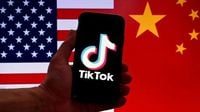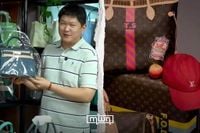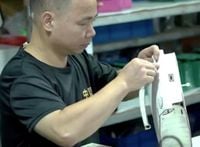In an unprecedented turn of events amid the ongoing trade war between the United States and China, Chinese manufacturers have taken to social media platforms like TikTok to reveal startling truths about the production of luxury goods. This revelation has sparked a global conversation about the origins of high-end products, particularly those marketed as ‘Made in America’ or from other Western nations.
As tensions escalate, China recently announced a staggering 125% tariff on American imports, a direct response to President Donald Trump’s threat of a 145% tariff on Chinese goods. This new tariff took effect on April 12, 2025, and has sent ripples through the global economy, prompting manufacturers to rethink their sales strategies.
One Chinese OEM factory, which has been producing goods for luxury brands such as Gucci, Prada, and Louis Vuitton for over 30 years, stated in a viral TikTok video that it has been the backbone of luxury fashion production. The factory’s representative claimed, “There is nothing we haven’t made; we know the craft very well.” This statement has resonated with viewers, prompting many to question the authenticity and pricing of luxury items.
According to the video, up to 80% of luxury handbags are manufactured in China, regardless of the country of origin printed on their labels. This revelation has led consumers to reconsider their purchasing decisions, with many now seeking to buy directly from manufacturers to avoid inflated prices associated with luxury branding. As one TikTok user noted, “I’m going to try and buy directly from the manufacturer… even with the markup for importing the good, the cost will be incomparably less than what these fashion houses charge for the exact same product.”
This trend has not only exposed the gap between the retail prices of luxury goods and their actual production costs but has also sparked debate about the perceived value of these items. For instance, a supplier of Birkin bags revealed that a bag sold for $34,000 could be produced for as little as $1,400. “More than 90% of the price is for the logo,” the supplier stated, emphasizing that consumers could access the same quality materials without the luxury label.
As the trade war intensifies, the implications for American consumers are significant. Many are now questioning why they should continue paying premium prices for items that could be sourced directly from Chinese manufacturers at a fraction of the cost. This sentiment is echoed across social media, where users are encouraging one another to cut out the “middle man” and purchase directly from the source.
In response to the tariffs, Chinese manufacturers are also promoting the idea that the label ‘Made in China’ does not equate to inferior quality. One TikTok video highlighted that 42% of Chanel cosmetics are crafted by Chinese artisans, challenging the notion that luxury goods are exclusively produced in Europe. “We don’t do ‘cheap goods,’ we do understated luxury,” the video declared.
As the narrative unfolds, it becomes increasingly clear that the luxury market is facing a reckoning. The perception that luxury brands are synonymous with high quality is being challenged by these revelations. With many consumers now aware that their beloved luxury items may be produced under similar conditions as fast fashion, the allure of exclusivity is fading.
Notably, the U.S. government has attempted to navigate this complex landscape by exempting certain consumer electronics from the punitive tariffs. These exemptions include critical items like smartphones and laptops, which are essential for American tech companies such as Apple and Nvidia. However, these measures have done little to quell the growing unrest among consumers who are now more aware of the global supply chain intricacies.
Amidst this turmoil, the Chinese government has also hinted at potential retaliatory measures, including a ban on Hollywood films, further complicating the cultural exchange between the two nations. As tensions rise, experts are warning that the trade war may have lasting implications for both economies.
In light of these developments, the question remains: how will American consumers respond to the unmasking of luxury brands? With many now aware that the high prices often reflect marketing rather than quality, it seems that the traditional luxury market may be in for a significant transformation.
This situation serves as a modern twist on the classic folktale, “The Emperor’s New Clothes,” where the truth about luxury goods is laid bare. Just as the emperor was deceived by con men, consumers are now being encouraged to question the status quo and seek the truth behind the luxury label.
As the conversation continues to evolve on social media, it is clear that the dynamics of consumerism are shifting. The once unassailable fortress of luxury branding is now under siege, and the revelations from Chinese manufacturers are leading the charge. With tariffs continuing to rise and the global economy in flux, the future of luxury consumption may be forever altered.
In summary, as Chinese manufacturers expose the realities behind luxury goods, consumers are left to ponder the true value of what they purchase. The trade war may have prompted a reevaluation of luxury, but it has also opened the door for new purchasing paradigms that could redefine how we view and acquire luxury items.








